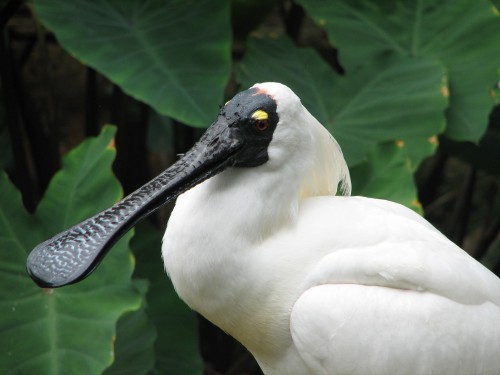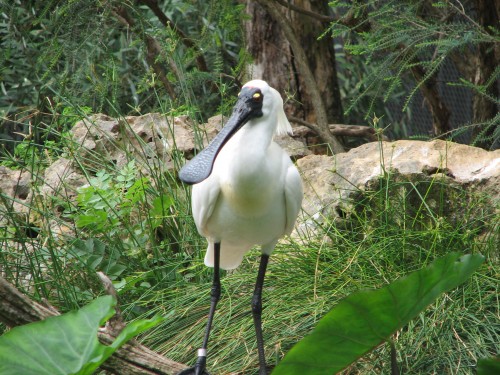Royal Spoonbill
Spoonbills would have to be one of my favourite of all of the wonderful birds we have here in Australia. It was another species, the Yellow-billed Spoonbill that was , in part, responsible for me becoming a birder. I was fascinated to see one feeding in the rock pools of Chambers Gorge in the Flinders Ranges. This was in the mid 1970s. Because it is in the harsh, arid far north of South Australia, this gorge only has water intermittently.
I didn’t have a far to travel to see the bird shown in today’s photo, a Royal Spoonbill. It was taken in one of the walk through aviaries in the Adelaide Zoo, a mere hour’s drive from my home.
Royal Spoonbill
Whenever I go out birding, I delight in seeing spoonbills. My favourite would have to be the Yellow-billed Spoonbill, but I also enjoy seeing the Royal Spoonbill. We only have the two species of spoonbills here in Australia.
Sometimes in the natural environment it is not easy to get up very close to the birds like I’ve managed in this series of photos. On this occasion I was photographing a captive bird in a walk-through aviary at the Adelaide Zoo.
The Royal Spoonbill is found throughout Australia where there is suitable habitat, except for the drier areas of South and Western Australia. You may notice in the photos on this post that the bird has a rather prominent plume of feathers coming from its head, prominent yellow marks above the eyes and a small red mark on the forehead. All these indicate breeding plumage; there was a nest in a tree planted in the aviary.
I must say that I’m struck by the yellow mark over the eyes; it gives the bird something of an evil look!
Further reading:
Royal Spoonbill, Adelaide Zoo, South Australia
Royal Spoonbills are found throughout much of Australia where there is suitable habitat. They are absent from the drier inland areas and are rare in southern Western Australia. They are sometimes seen in the company of our other species of spoonbill, the Yellow-billed Spoonbill.
Their preferred habitat includes shallow waters, both coastal and inland, estuaries, edges of lakes, dams and wetlands, tidal mudflats and irrigated pastures. Their nest is a shallow platform of sticks, often over water and often in association with other waterbirds such as cormorants. During breeding the adults have a conspicuous plume of white feathers on the back of the head.
The photo above was taken in a walk through aviary at the Adelaide Zoo, South Australia.
Further reading:
Birding at Mallacoota
On our visit to Mallacoota in far eastern Victoria in January we went for an after dinner walk along the foreshore and estuary of the river. It was a calm, warm evening and we had a pleasant time exploring this lovely spot for the first time. We decided that this is one place we needed to revisit – and stay four or five days at the very least.
In the quiet estuary we saw many Black Swans, Australian Pelicans, a few Pied Oystercatchers and three Royal Spoonbills.
While on our walk we saw several Great cormorants as well as some Little Pied Cormorants. Two Whistling Kites patrolled the shallows in the company of a lone White-bellied Sea Eagle. I’ve not seen too many sea eagles in all of my birding, so this was something special. I was surprised though that there were not many ducks in the estuary. In fact I only recorded a few Australian Wood Ducks. Perhaps the kites and eagle had scared them off.
The inlet is an ideal haven for fishermen, and this is iluustrated by the large number of boats present in the water and on trailers in the caravan park. There are also boats offering cruises on the river, like the one shown below.









